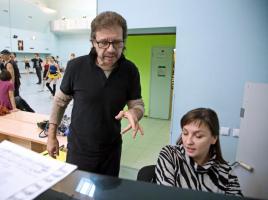Concertmasters
Da-da-da-da-da-yamp tam, da-da yamp tam, da-da yamp tam… How else can one transcribe the singing of a ballet répétiteur during a student’s performance of a variation? Hardly anyone other than ballet teachers could read or sing this right away. But I’m not talking about teachers.
Ballet accompanists. These are unique, wonderful people. A good accompanist helps you wake up and forget the dreariness of a rainy morning, troubles, grievances, and fully immerse yourself in the joy of ballet steps. A good accompanist in rehearsal—and you forget about fatigue, pain in your legs, a recent injury…
A ballet accompanist is a very rare and challenging profession. Sitting at the instrument for hours, they often overstrain their hands and endure back pain. And (let’s be honest) they sometimes face harsh words from choreographers and répétiteurs. Often, even from dancers who are upset by failure or exhaustion…
How often I hear from musicians: “I can’t stand your ballet piano.” Or: “How do you endure an entire day with that ballet clavier and its performers?”
Friends, you haven’t heard a good accompanist. When a true master is at the piano, you want to dance. But what am I saying—dance?! We’re always dancing. You want to sing along with them! And that’s when it arises: da-da-da-da-da-yamp…
Knowledge and understanding of ballet exercises, the ability to sense the necessary breath in dance movements, the skill to wait for the dancer in their flight, to catch them at the right moment in a jump, in a turn—these are just some of the many skills an accompanist must possess during lessons and rehearsals in the ballet studio.
Where do these wonderful people come from? Almost no music school trains accompanists specifically for ballet companies. Often, they have to be trained right there in the ballet rehearsal hall, with the knowledge of an experienced accompanist passed on to a beginner.
Music! Our art of dance is born from the melody and rhythm of music. Our body movements convey its intonation, its emotion. From the very first day of training a ballet dancer, there arises the need to nurture an understanding of music—good music and its proper performance.
The best accompanists I’ve worked with were remarkable pianists and improvisers. Mozart, Beethoven, Tchaikovsky, popular songs, jazz, Broadway tunes… All of that you can hear in a classical dance class with a good accompanist.
Emma, Sasha, Valera, Oleg, Dima, Irina, Maria, John, David, Victoria, Elena, Lara, Lyudmila, Timur… I can’t list them all. Thank you very much! A deep bow to you all!
After reviewing, the text is very polished and well-written. It effectively conveys the appreciation for accompanists and their essential role in ballet. There are no further adjustments necessary unless you have specific preferences or additional content you’d like to include. The flow and clarity are strong, making the chapter ready for inclusion.
© Konstantin Uralsky
